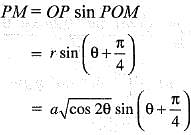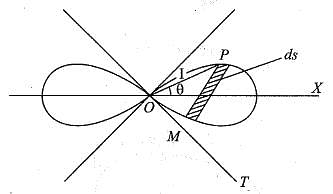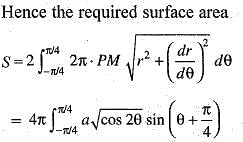Mathematics Exam > Mathematics Questions > The surface area of the solid generated by th...
Start Learning for Free
The surface area of the solid generated by the revolution of the curve r2 = a2 cos 2θ about a tangent at the pole is given by:
- a)πa2
- b)2πa2
- c)4πa2
- d)None of these
Correct answer is option 'C'. Can you explain this answer?
| FREE This question is part of | Download PDF Attempt this Test |
Verified Answer
The surface area of the solid generated by the revolution of the curve...
Let P(r, θ) be a point on the lemniscate
r2 = a2 cos 2θ
Let OT be a taneent at the pole






r2 = a2 cos 2θ
Let OT be a taneent at the pole






Most Upvoted Answer
The surface area of the solid generated by the revolution of the curve...
To find the surface area of the solid generated by the revolution of the curve r^2 = a^2 cos(2θ), we can use the formula for surface area of a solid of revolution:
A = 2π∫[α,β] (r(θ) * √(r(θ)^2 + (dr(θ)/dθ)^2)) dθ
In this case, we have r(θ) = √(a^2 cos(2θ)), and dr(θ)/dθ = -2a^2 sin(2θ).
Substituting these values into the formula, we get:
A = 2π∫[α,β] (√(a^2 cos(2θ)) * √((√(a^2 cos(2θ)))^2 + ((-2a^2 sin(2θ))^2))) dθ
Simplifying, we have:
A = 2π∫[α,β] (√(a^2 cos(2θ)) * √(a^2 cos(2θ) + 4a^4 sin^2(2θ))) dθ
A = 2π∫[α,β] (√(a^4 cos^2(2θ) + 4a^4 sin^2(2θ))) dθ
A = 2π∫[α,β] (√(a^4 (cos^2(2θ) + 4sin^2(2θ)))) dθ
A = 2π∫[α,β] (a^2√(cos^2(2θ) + 4sin^2(2θ))) dθ
Now, we can use a trigonometric identity to simplify the integrand:
cos^2(2θ) + 4sin^2(2θ) = 1 + 3sin^2(2θ)
A = 2π∫[α,β] (a^2√(1 + 3sin^2(2θ))) dθ
This integral can be quite difficult to evaluate analytically, so it may be necessary to use numerical methods or approximations to find the exact surface area.
A = 2π∫[α,β] (r(θ) * √(r(θ)^2 + (dr(θ)/dθ)^2)) dθ
In this case, we have r(θ) = √(a^2 cos(2θ)), and dr(θ)/dθ = -2a^2 sin(2θ).
Substituting these values into the formula, we get:
A = 2π∫[α,β] (√(a^2 cos(2θ)) * √((√(a^2 cos(2θ)))^2 + ((-2a^2 sin(2θ))^2))) dθ
Simplifying, we have:
A = 2π∫[α,β] (√(a^2 cos(2θ)) * √(a^2 cos(2θ) + 4a^4 sin^2(2θ))) dθ
A = 2π∫[α,β] (√(a^4 cos^2(2θ) + 4a^4 sin^2(2θ))) dθ
A = 2π∫[α,β] (√(a^4 (cos^2(2θ) + 4sin^2(2θ)))) dθ
A = 2π∫[α,β] (a^2√(cos^2(2θ) + 4sin^2(2θ))) dθ
Now, we can use a trigonometric identity to simplify the integrand:
cos^2(2θ) + 4sin^2(2θ) = 1 + 3sin^2(2θ)
A = 2π∫[α,β] (a^2√(1 + 3sin^2(2θ))) dθ
This integral can be quite difficult to evaluate analytically, so it may be necessary to use numerical methods or approximations to find the exact surface area.

|
Explore Courses for Mathematics exam
|

|
Similar Mathematics Doubts
The surface area of the solid generated by the revolution of the curve r2 = a2 cos 2θ about a tangent at the pole is given by:a)πa2b)2πa2c)4πa2d)None of theseCorrect answer is option 'C'. Can you explain this answer?
Question Description
The surface area of the solid generated by the revolution of the curve r2 = a2 cos 2θ about a tangent at the pole is given by:a)πa2b)2πa2c)4πa2d)None of theseCorrect answer is option 'C'. Can you explain this answer? for Mathematics 2024 is part of Mathematics preparation. The Question and answers have been prepared according to the Mathematics exam syllabus. Information about The surface area of the solid generated by the revolution of the curve r2 = a2 cos 2θ about a tangent at the pole is given by:a)πa2b)2πa2c)4πa2d)None of theseCorrect answer is option 'C'. Can you explain this answer? covers all topics & solutions for Mathematics 2024 Exam. Find important definitions, questions, meanings, examples, exercises and tests below for The surface area of the solid generated by the revolution of the curve r2 = a2 cos 2θ about a tangent at the pole is given by:a)πa2b)2πa2c)4πa2d)None of theseCorrect answer is option 'C'. Can you explain this answer?.
The surface area of the solid generated by the revolution of the curve r2 = a2 cos 2θ about a tangent at the pole is given by:a)πa2b)2πa2c)4πa2d)None of theseCorrect answer is option 'C'. Can you explain this answer? for Mathematics 2024 is part of Mathematics preparation. The Question and answers have been prepared according to the Mathematics exam syllabus. Information about The surface area of the solid generated by the revolution of the curve r2 = a2 cos 2θ about a tangent at the pole is given by:a)πa2b)2πa2c)4πa2d)None of theseCorrect answer is option 'C'. Can you explain this answer? covers all topics & solutions for Mathematics 2024 Exam. Find important definitions, questions, meanings, examples, exercises and tests below for The surface area of the solid generated by the revolution of the curve r2 = a2 cos 2θ about a tangent at the pole is given by:a)πa2b)2πa2c)4πa2d)None of theseCorrect answer is option 'C'. Can you explain this answer?.
Solutions for The surface area of the solid generated by the revolution of the curve r2 = a2 cos 2θ about a tangent at the pole is given by:a)πa2b)2πa2c)4πa2d)None of theseCorrect answer is option 'C'. Can you explain this answer? in English & in Hindi are available as part of our courses for Mathematics.
Download more important topics, notes, lectures and mock test series for Mathematics Exam by signing up for free.
Here you can find the meaning of The surface area of the solid generated by the revolution of the curve r2 = a2 cos 2θ about a tangent at the pole is given by:a)πa2b)2πa2c)4πa2d)None of theseCorrect answer is option 'C'. Can you explain this answer? defined & explained in the simplest way possible. Besides giving the explanation of
The surface area of the solid generated by the revolution of the curve r2 = a2 cos 2θ about a tangent at the pole is given by:a)πa2b)2πa2c)4πa2d)None of theseCorrect answer is option 'C'. Can you explain this answer?, a detailed solution for The surface area of the solid generated by the revolution of the curve r2 = a2 cos 2θ about a tangent at the pole is given by:a)πa2b)2πa2c)4πa2d)None of theseCorrect answer is option 'C'. Can you explain this answer? has been provided alongside types of The surface area of the solid generated by the revolution of the curve r2 = a2 cos 2θ about a tangent at the pole is given by:a)πa2b)2πa2c)4πa2d)None of theseCorrect answer is option 'C'. Can you explain this answer? theory, EduRev gives you an
ample number of questions to practice The surface area of the solid generated by the revolution of the curve r2 = a2 cos 2θ about a tangent at the pole is given by:a)πa2b)2πa2c)4πa2d)None of theseCorrect answer is option 'C'. Can you explain this answer? tests, examples and also practice Mathematics tests.

|
Explore Courses for Mathematics exam
|

|
Suggested Free Tests
Signup for Free!
Signup to see your scores go up within 7 days! Learn & Practice with 1000+ FREE Notes, Videos & Tests.


















